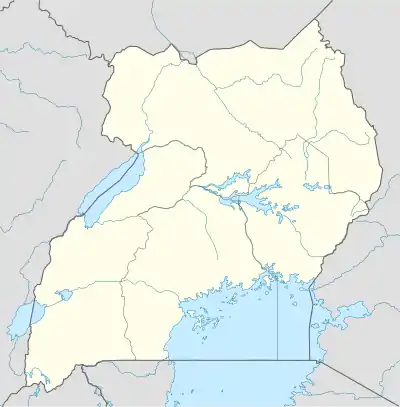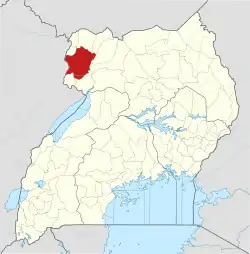Ombaci
Ombaci is a neighborhood in Arua City in the Northern Region of Uganda.[1]
Ombaci | |
|---|---|
 Ombaci Location in Uganda | |
| Coordinates: 03°03′53″N 30°56′17″E | |
| Country | |
| Region | Northern Uganda |
| Sub-region | West Nile sub-region |
| District | Arua District |
| Elevation | 3,701 ft (1,128 m) |
Location
Ombaci is located in Arua City, in the West Nile sub-region, in Northern Uganda. It is located about 6 kilometres (4 mi), by road, north east of the central business district of Arua.[2] The geographical coordinates of Ombaci are:03°03'53.0"N, 30°56'17.0"E (Latitude:3.064722; Longitude:30.938056).[1] Ombaci lies at an average elevation of 1,128 metres (3,701 ft) above sea level.[3]
Overview
Ombaci, in the local Lugbara language, loosely translated, means "enmity exists", a reference to past conflicts in the area. In this neighborhood, as one travels north from Arua, the road forks into two. The left fork, called Kaya Highway continues north-westwards to Koboko, Oraba and Kaya, South Sudan. The right fork, called Rhino Camp Road continues north-eastwards to Wandi and eventually to Rhino Camp.[1]
Three of the most prominent landmarks in the neighborhood, are (a) Ombaci Primary School (b) Ombaci Roman Catholic Church (c) St. Joseph's College, Ombaci (d) Comboni Missionaries Centre Ombaci and (e) St. Andrew Church of Uganda. It is in this location that the Ombaci Massacre occurred, in June 1981.[4]
Ombaci Massacre
In April 1979, Idi Amin Dada was toppled from power by the Tanzania People's Defence Force (TPDF) and the Uganda National Liberation Army (UNLA). Idi Amin was a native son of the West Nile sub-region and many of the soldiers in his army came from this region too. As the victorious UNLA soldiers marched northwards to Arua, civilians, and former Amin soldiers took refugee in the compound of the Catholic mission and St. Joseph's College Ombaci, both of which were surrounded by a common perimeter fence.[4][5]
On Wednesday, 24 June 1981, six months into the second reign of Apollo Milton Obote, UNLA soldiers arrived at the Ombaci Catholic Mission and adjoining secondary school. They began to indiscriminately kill civilians, women, children and the elderly; by shooting, bludgeoning, stabbing, lancing, stomping, kicking and exploding ordinance (rocket propelled grenades).[6][7]
The exact number of people killed is not accurately known. Credible sources have quoted a number as "over 80".[6] Another credible source reports that the secondary school grounds contain a mass grave for 97 victims.[4]
A large number of survivors, estimated at about 400 were still alive in May 2019, living with physical and mental injuries as a result of the assault.[8]
See also
References
- Google (21 April 2020). "Location of Ombaci, Arua District" (Map). Google Maps. Google. Retrieved 21 April 2020.
- Google (21 April 2020). "Driving Distance Between Downtown Arua And St. Joseph's College, Ombaci" (Map). Google Maps. Google. Retrieved 21 April 2020.
- Elevation Map (21 April 2020). "Elevation of Ombaci, Arua District". Elevationmap.net. Retrieved 21 April 2020.
- Harold Acemah (30 September 2018). "St Joseph's College Ombaci Celebrates 75th Anniversary". Daily Monitor. Kampala. Retrieved 21 April 2020.
- West Nile Web (18 January 2018). "The 1981 Ombaci Massacre". Arua: West Nile Web. Retrieved 21 April 2020.
- Ismail Anguliga (22 February 2006). "This Is The Truth About The Ombaci Massacre". New Vision. Kampala. Retrieved 22 April 2020.
- Owen Erima (19 June 2015). "The untold story of Ombaci Massacre in Uganda—meet Veronica Eyotaru, a survivor". Owen Erima. Retrieved 21 April 2020.
- Felix Warom Okello (30 May 2019). "38 years later, Ombaci victims yet to get justice". Daily Monitor. Kampala. Retrieved 21 April 2020.
